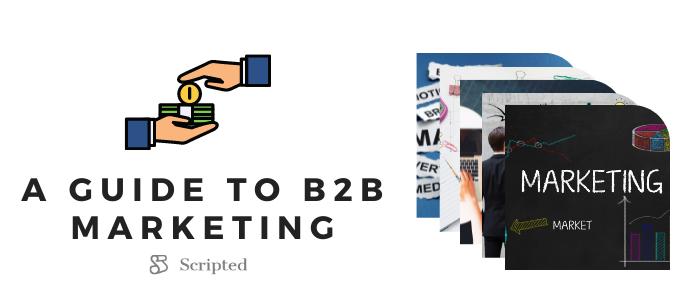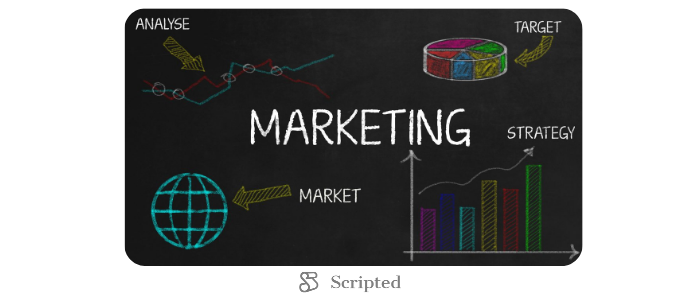- Blog Home
- Industries
- Ciara Antolini
- A Guide To B2b Marketing
A Guide to B2B Marketing

Marketing is the art and science of promoting products or services to the people who are most likely to purchase them. Techniques include creating engaging, shareable content, advertising, or even attending trade shows and conferences. It might seem that most companies are marketing their goods to individual consumers. These types of organizations are known as B2C providers or business-to-consumer.
What might surprise you is that around one in four companies in the United States are actually B2B: Business-to-business. These are outfits that provide their offerings specifically to other businesses. Unsurprisingly, the marketing techniques they use must be far more highly targeted.
Whether they’re selling soda or salt, it makes sense for B2C companies to leverage media such as TV commercials, YouTube ads, and viral social media content. Multiple types of broadcast advertising can be cost-effective if a business produces products that appeal to a wide range of demographics.
For instance, a company that sells sunscreen could sell to a wider audience than a company that sanitizes shopping carts. The latter needs to target grocery stores, big box stores, and other retailers with shopping carts. Paying huge amounts of money for a TV ad that would only reach a few decision-makers in the relevant industries is a waste of marketing funds.
To succeed, companies that target other businesses need to rely on different strategies to connect with customers. This is often referred to as B2B marketing, and businesses need to adjust their marketing and content strategies to succeed in this arena.
What is B2B Marketing?

B2B or business-to-business marketing is any marketing technique used by businesses to sell products or services to other businesses. Many of the actual methodologies are similar to B2C, such as advertising and face-to-face conversations. The differences are usually in how target audiences are defined, the degree of focus, and the reliance on data and feedback from clients.
The main purpose of B2B marketing is to grow the business while gathering critical customer data that allows marketers to continuously hone their campaigns. This means finding ways to introduce their products and services to businesses with pain points that those offerings can resolve. There’s also a strong focus on centering the client, building meaningful relationships, and managing and maintaining those relationships over time.
An Example of B2B Marketing
Let’s say you own a website development startup. You want to connect with new business owners to try to sell them your services. An ideal time to make these connections is when they’re thinking about investing in their first corporate website. What’s the best way to find these potential buyers?
You could pay for a social media ad, but as a startup, you might not have the budget or marketing expertise to ensure the advertisement successfully targets B2B buyers. While business decision-makers are increasingly online — B2B marketers now spend 22% of their budgets on social media — Facebook or Instagram might not be the best place to link up with people struggling to start a website.
Instead, you could connect with the local chamber of commerce to see if you can advertise in the materials that the chamber distributes to new business owners. Even if it costs more initially, you're likely to see a higher return on your investment because of how well-defined your target audience is.
Understanding the target audience is the key to unlocking the potential of your B2B marketing efforts. Mailchimp is one company that excels in this area. Rather than constantly bombarding potential leads with information about their email services, they’ve created a newsletter called Courier. Courier is a snazzy, easy-to-navigate website offering news from across the industries Mailchimp wants to target. By providing relevant content, Mailchimp has positioned itself as a trusted resource and increased the chances of companies approaching Mailchimp when they need email-related solutions.
This type of content marketing is also known as demand generation. It relies on engaging, thought leadership content that ties into current events or talking points. Scripted’s talented pool of writers creates content like this every day for companies all over the world. To find out how this could elevate your B2B marketing efforts, schedule a call with a content specialist today.
Targeting the Right Clients for B2B Marketing

B2B marketers target other businesses as their customers. These may be small, medium, or large enterprises. Marketing professionals also target decision-makers who work in these companies, such as CEOs, vice presidents, and financial officers.
Social media can be a critical part of your B2B campaign, but as we already noted, you have to understand how to target your campaign carefully to maximize your marketing budget. One way to make this more cost-effective is to use generative AI to create multiple social media posts and try them out across different channels. A/B testing or split testing is critical here. You can use prompts to get AI to change one element of each post and gather data on which is most effective. If you want to get AI-generated content for your B2B campaigns, simply register with Scripted completely free.
Data collection and analysis are essential for B2B marketers. This helps assess the performance of campaigns and optimize them for growth on that success. Data collation also helps marketers hone target audiences and buyer personas more finely, assuring maximization of marketing budgets.
B2B vs. B2C Marketing: What's the Difference?

B2C consumers are individuals who shop in department stores, grocery stores, online shops, or specialty stores. They may also shop via links on social media ads and through company affiliates. They're the most likely to respond to influencer marketing, although B2B influencer marketing is on the rise.
Examples of B2C marketing include:
- A jewelry store using a celebrity to influence individuals on Instagram
- An ice cream parlor running a 2-for-1 offer on its landing page during the summer vacation
- A home organization app targeting busy parents via a compellingly written YouTube ad
You can see that these are all methods of influencing the purchasing decisions of individuals by addressing particular needs that the company has identified.
B2B marketing works in the same way, but it targets the decision-makers of other companies. For example:
- A data integration company regularly writing blog posts and articles about technology news
- A corporate cleaning company sharing video testimonials from other business customers
- A customer relationship management (CRM) system provider offering a discounted subscription for companies that take out a longer contract
Again, each marketing technique looks at the needs of the potential end user. However, in these instances, the marketer has identified pain points such as difficulty keeping up with technological advances, knowing which company to trust, and limited budgets. There’s a clear intersection between B2C and B2B marketing, particularly as more B2B decision-makers utilize channels like Facebook and Instagram. However, the best B2B marketers know that they must always keep the potential client’s needs and problems at the center of their strategies.
B2B Marketing Is Critical for Organizational Growth

It almost goes without saying that marketing is critical for all businesses. Many markets are crowded, and it can be difficult to stand out, particularly as a startup. There are over 72,000 startup businesses in the United States, so understanding the intricacies of B2B marketing is essential for gaining an edge over competitors.
This is why so many businesses gain support from external agencies or resources. This might include buying content, onboarding freelance marketing professionals, utilizing software as a service (SaaS) to analyze marketing data, or even partnering with other businesses.
Creating Partnerships to Serve More Customers
Creating partnerships with other B2B businesses is an excellent marketing strategy worth exploring. You could partner with a company that offers similar services and help each other. For example, a corporate event coordinator could partner with an event caterer. A web development company could partner with a copywriting agency.
Take a look at the partnership between Red Bull and GoPro. Red Bull gave GoPro access to over 1800 of their sporting events. GoPro was able to build its brand as a trusted provider of video photography solutions. Red Bull gained a huge amount of media attention via the many videos shared by the camera provider. Both brands benefited, and the cost for both was minimal as they pooled their resources to make it happen.
Consider who you could partner with to make your brand even more impactful.
B2B Strategy Basics

To be successful in B2B marketing, you need a refined B2B marketing strategy. This means carefully aligning every marketing decision with your marketing goals, making B2B promotion a holistic endeavor. Chief marketing officers (CMOs) often engage other executives, third parties, and data analysts. They even get direct feedback from clients to ensure their marketing processes drive business growth. Documenting a marketing plan based on all these insights helps you stay organized and reach your business goals.
Start with the Buyer’s Journey
The Buyer’s Journey is the steps the buyers follow when making a purchase or signing up for a subscription. Whether you're marketing to consumers or businesses, every customer or client goes through a version of the Buyer’s Journey. By understanding the steps in the process, you can better understand how to market to people in different parts of the buying process.
The Buyer’s Journey consists of three stages:
- Awareness
- Consideration
- Decision
The needs of the buyer are different during each stage, which is why you have to adjust the content of your marketing accordingly. By the time a potential customer becomes aware of your company, they may be in any of those stages. Developing your content in the right way makes it possible to guide those potential customers into making a purchase. Some marketers refer to these stages as different parts of a sales funnel: the top, middle, or bottom of the funnel. The bottom of the funnel is where clients are considering making a purchase.
Awareness Stage
The first stage in the process is the awareness stage. This happens when a potential customer realizes they have a specific problem. Companies tend to buy goods and services only when they really need them, especially when budgets are tight. Companies are likely to try to solve problems themselves, but many corporate issues simply cannot be solved in-house. This awareness stage is when they're prepared to go looking for outside help.
Marketers often refer to problems as pain points. This means a challenge or frustration that is causing friction within a business process for the potential client. Pain points can be as simple as an HR process that takes too long. This might be fixed by a SaaS provider that offers solutions for faster collation of personnel data. However, they can also be incredibly complex. For example, a business that’s 50 years old might need an entirely new computer system, but it doesn't have the option to take its legacy systems offline. Someone who could fix this issue could potentially create a long-lasting, lucrative partnership.
Marketers must perform extensive market research to understand client pain points and place the buyer at the hub of their marketing efforts.
Consideration Stage
The consideration stage is where customers try to understand their problem and the potential fixes available. The goal for most B2B decision-makers is to collect data that can help them find the right solution. Once they understand the intricacies of their problem, they can look for a provider that has the right solution for them.
This is an ideal opportunity for B2B marketers to provide content that answers client’s questions. Creating blogs, articles, or even whitepapers on topics that matter to potential buyers makes them more likely to trust your organization when the time comes to make a purchase.
Scripted’s carefully curated network of subject matter experts (SMEs) can help you create on-brand, thoughtful content that gets you noticed in your industry. Register to get your free account and explore our AI-powered options, and upgrade at any time to access writers trusted by B2B companies worldwide.
Decision Stage
The final stage is where customers commit to purchasing a product or service to address their pain points. There are usually multiple providers of business solutions, and your audience is looking for the solution that works best for them. With the right marketing, you can convert these audience members into paying customers.
This is the ideal time to promote demos of your product, either face-to-face at exhibitions and events or via video services such as YouTube, Instagram Reels, or even embedded in your own website. Case studies and testimonials are also excellent resources for buyers who are ready to commit to a trusted provider. If you’re utilizing email marketing, a follow-up email with additional, personalized information is a great way to build a profitable relationship and reassure a potential client that you’re on hand to help out with their problem.
B2B Marketing Strategies

There are, of course, dozens of B2B marketing strategies that you can try. We’ve highlighted some of the most common here. Remember, if you need content for any of these marketing methodologies, you can register with Scripted for free and gain instant access to AI-generated emails, blog posts, ad content, and more.
Email Marketing
Email marketing utilizes email sequences to stay in touch with clients, keep them informed of the latest news about your company or products, and build relationships. It can be used to send promotional messages and press releases or remind buyers who paused partway through the process that they have goods in their cart.
Many email marketing software solutions utilize AI to suggest templates, automate sending, or send quick responses. Generative AI content is also useful for creating email content as long as marketers use the right prompts to generate on-brand content.
Content Marketing
B2B content marketing means any use of written, visual, or audio content that connects businesses to their buyers. This content may be informative, educational, entertaining, or promotional material. It can also be blog posts and/or videos. Its main purpose is to give detailed information about a company's products or services. However, as we’ve seen, content can also cover adjacent topics or explore subjects important to the client. Content marketing is also a great way for companies to tell their stories or highlight work they’ve done within their communities.
Scripted specializes in providing content marketing solutions to businesses of all sizes via a one-stop platform that combines AI efficiency with human expertise. Companies can hire writers, generate their own content for free, or work with content specialists who can provide advice ranging from content creation workflows to publishing and promotion guidance.
PPC Campaigns
A PPC campaign, or pay-per-click marketing, is when companies get business through pay-per-click costs for advertisements. This can be done using online advertising or by having a direct link to their website. It could also be done through search engine optimization techniques, which involves adding keywords in the title and content of their web pages as well as on email campaigns and social media sites like Facebook and Twitter.
PPC campaigns can be extremely effective because ads are only shown to qualified targets. For instance, attaching a PPC campaign around the keywords "brochure printer" would end up with a campaign targeting businesses that need to hire a printing company to print marketing brochures. Your business wouldn't pay to show this ad to consumers who don't have businesses or this need. Paying for an advertisement in a local newspaper would be seen by everybody who reads it, not just business owners.
AI is an excellent solution for generating ad copy at scale. Because most PPC adverts are very short, AI can generate multiple different versions of these fast. This allows marketers and data analysts to work together and discover which ads have the most impact.
How to Define Your Audience

Whichever methods you use, defining your audience is the first critical step in B2B marketing. To do this, you need to first decide what you want to sell and who your target audience is. This means understanding the pain points your product or service addresses and who has this issue.
You should also be able to state exactly why a business should choose to buy from you. You can do this by carefully researching what their current problems are and what they perceive to be the right solution based on past experiences with other providers. This allows you to highlight why your product solves their problem better, faster, or smarter than competitors. You can use this information to inform your marketing campaigns.
Market research also helps you determine what kinds of materials you should be using. You can figure out the ideal length and number of emails, as well as the ideal content length for your blogs or articles. You can use this information to determine how many times you can contact your audience before it transforms from useful updates into annoying spam.
Other Considerations for B2B Marketing

Developing an effective, impactful B2B marketing strategy might look very different from any B2C marketing campaigns you may have worked on in the past. Let’s highlight some more critical differences between B2C and B2B marketing.
Larger Sales, Harder Sells
B2B marketing often yields larger sales in terms of money spent or committed in a single transaction. Businesses have the resources to make larger purchases or multiple purchases over time. This is a great thing since it leads to more revenue. However, it also means that you will experience a harder sell.
Selling to a business is much harder than selling to an individual consumer. There are often multiple people in the business that you have to convince on a sale, especially if it will be a recurring sale that impacts their operations. Plan for the sales process to take longer than you might expect and understand that you may have to put more effort into each sale.
Higher Marketing Costs are Common
B2B marketing can also cost more than other types of marketing. You will likely have to achieve a long reach with a wider audience to maintain B2B sales. Multiple companies often target businesses, each wanting to offer a different solution to their problems. This makes many companies resilient to some marketing methods. You may have to invest more time and money into your marketing operations to have a meaningful impact on your target audience.
Measure, Reassess, and Redesign Often
Your first attempts at crafting a B2B marketing strategy might not be a roaring success. This is common because it takes time, research, and ongoing data to develop a reliable marketing plan. When you start the marketing process, include a way to measure and analyze your performance. Keep the strategy points that work and redesign the ones that do not. Do this often to refine your strategy until it is effective and reliable, and remember that buyer needs are fluid. Be prepared to shift with transforming markets and client requirements.
Scripted specializes in creating content for businesses wanting to make a significant impact in their market. We offer specialist services for companies that need to create content at scale — ideal for starting new B2B marketing campaigns or beginning a new strategy to address a wider or changing market.
Register today for free and take advantage of AI-powered solutions from press releases to emails and so much more. When you want to utilize our team of industry expert writers, simply upgrade your plan and connect with a content creator who can produce content that converts — fast.
Published by Ciara Antolini on Wednesday, November 15, 2023 in Industries, Content Marketing, Guide, Marketing.